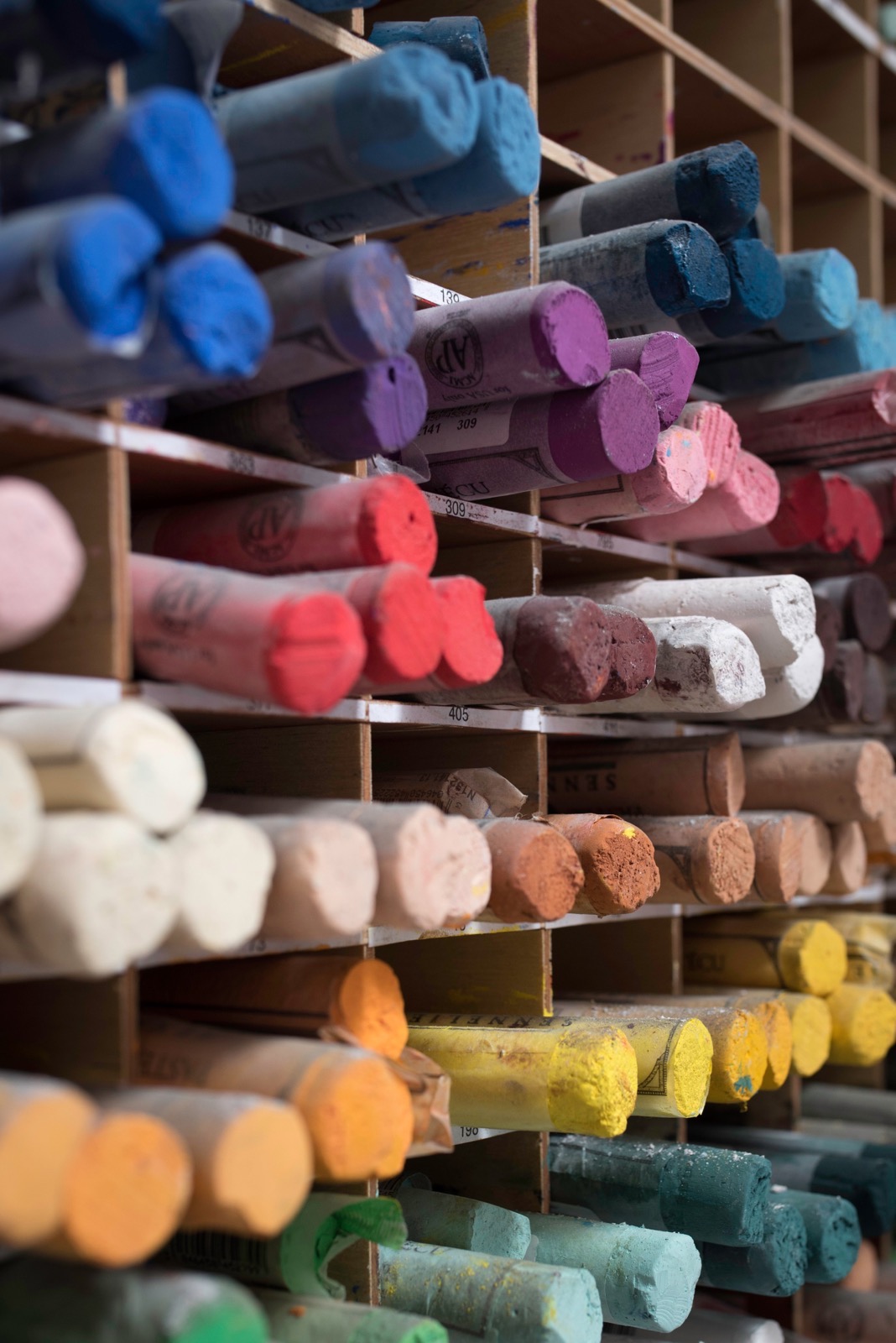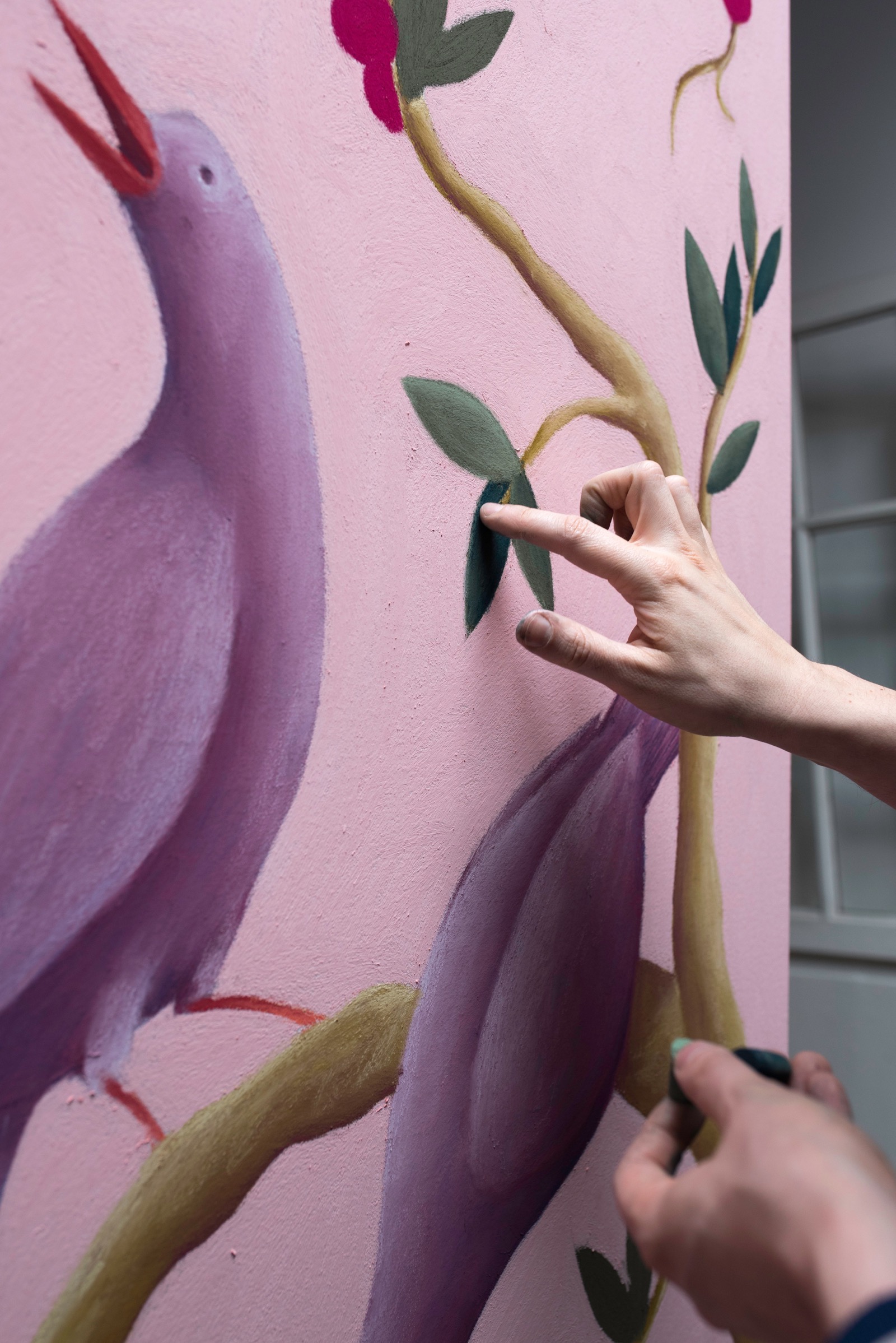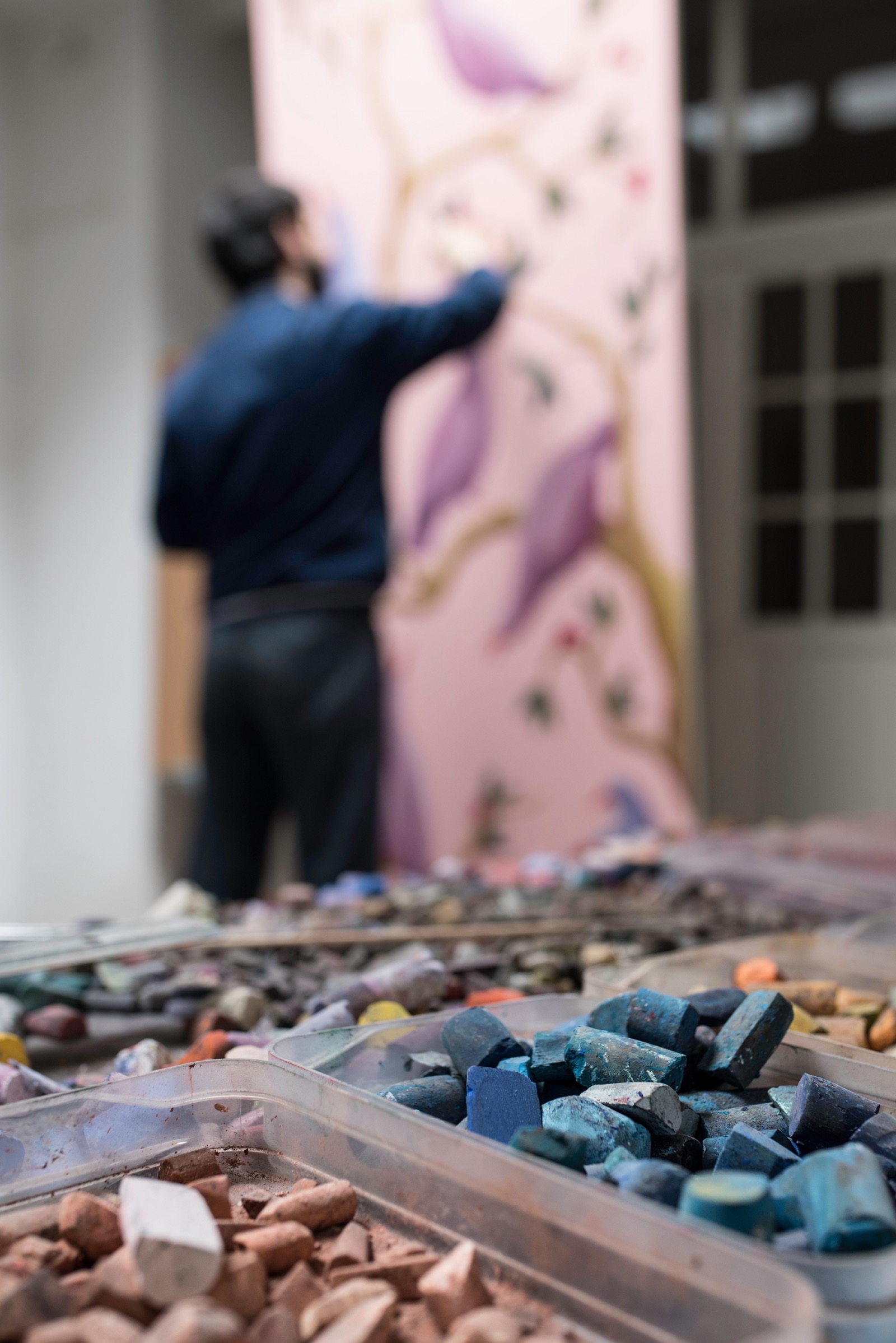
Swiss artist Nicolas Party would rather go to a museum than on a hike. “I look at art more than reality,” he says. He can, however, imagine gathering all painted trees, including the ones he is standing next to, into a single forest and walking through it. Such a forest would reveal deeper meaning and inner truths. “Trees open so much with their simplicity.”

In his studio in Brussels, he moves from the slender silhouettes and symmetrical crowns of his trees to a different composition inspired by a genre in classical Chinese painting called Flowers and Birds. Already in his working clothes, he contemplates a few final touches. He picks a dark green from his pastel cases, where all the colors are arranged in a spectrum, starts coloring the leaves, and then carefully blends the color with his fingertips.
Although the canvas has been treated “with a mix of wooden dust, water and a little bit of gesso that gives it a grip,” some of that pastel powder falls on the floor, but the effect is still dense and texturally engaging. Satisfied with the outcome, he reaches out to a tray on a mobile stainless steel workstation and drops the pastel in there. He then loosely taps the painting at the back to allow more dust to come off and contentedly says, “Now, this is ready to be framed.”
Nearby are the boxes that he uses to take a work to the framer. “All pastels need to be framed under glass or Plexiglass. They can get smudged otherwise.” Amidst the canvas rolls and wooden frames for stretching canvas are stacks of wooden circle cut outs that will be table tops for a café in Edinburgh. For this project, he has asked Sarah Margnetti, an artist friend and graduate of Ecole Van Der Kelen-Logelain, to paint a faux green marble surface. Party will paint faces and fruits on this optical illusion. His sample faces are precise and austere in their lines, but the fruits give a more playful tone to the overall composition subtly evoking Giuseppe Arcimboldo’s surrealist portraits of human heads made up of fruit. In addition to the tables, Party is creating a mural for the café, a landscape with shrubs, bushes, and columnar trees on a pink backdrop.
Another energetic mural already on the studio wall seems to stand alone, but Party believes the mural by itself is inadequate. To explain, he brings a pastel and loosely places it against the mural. “When you have one character, it is not interesting. By adding another layer, you start a conversation and all sorts of questions come up.” He realized this conception at his exhibition at the Dallas Museum of Art (2016) where he transformed a long corridor into an aquatic dreamscape, an enchanted land of contemplation and reverie, and made its leading feature a pastel of two androgynous figures, Two Men with Hats. “There is this mystery that floats over the artwork and you wonder. Who are they? Are they men? Are they brothers? and so on.”


For his June 2017 exhibition at the Hirshhorn Museum in Washington, he is planning a different kind of mural. There won’t be a juxtaposition of a mural and a separate canvas, but rather two murals superimposed. Party will give the curved walls of the gallery a solid color (probably a dark purple), and on that background, he will paint twenty oil paintings of sunsets and sunrises inspired by Swiss painter Felix Vallotton (1865 – 1925). He has eighteen days to complete the paintings and to create the long circular walk of sunsets and sunrises.
This poetic theme was prompted by the recent US elections and Barack Obama’s statement that “there is one thing we know for sure, the sun will rise tomorrow.” What will happen to the paintings when the show is over? “It’s like the sunset. It disappears. The funny thing with a mural is that you don’t see it anymore, but it’s here. They will just cover it. It’s like when the sun is on the other side of the planet. You don’t see it, but it’s here.”
Oil painting
Using oil paint, Nicolas Party painted the Hirshhorn’s circular galleries over the course of two weeks for the exhibition NICOLAS PARTY: SUNRISE, SUNSET
JUN 07–OCT 01, 2017.
The Swiss born Nicolas Party working in his studio
Nicolas Party works across a wide range of different media. Primarily known for his colour-saturated paintings and murals, he also makes painted sculptures, pastels, installations, prints and drawings.
Sunrise and Sunset
Studies featuring, sunrises and sunsets are among the few moments in the day when we are reminded that the universe is vast and its measure of time infinite.
One floor up is his drawing studio with a small terrace and a big skylight illuminating the room. Party takes a quick look at a yearly calendar on the wall and sits in his study area, which has a computer and a slender library filled with books and sketchbooks. The high-keyed colors and pictorial flatness of a pastel still life of a pile of peaches suggest he may indeed paint from real life. “No. What I do, is I work in stages. First comes a sketch. Then I do work on the computer that helps me refine my drawing. The final step is to do the outline of the drawing on transparent paper, so that I can project it.”
Giorgio Morandi influence
Another pastel nearby has a mild surrealist charm. In subtler earth tones, the two vessels depicted have been tweaked in scale, shading, and perspective, but Party wants to draw them again. “I bought a 3d printer which took two days to print those vessels. My plan is to observe these guys,” he says, his earnest gaze following the outline of the vessels near the edge of his work table. Inspired by the visual literacy demanded by the works of Giorgio Morandi (1890-1964), he attempts to walk in his shoes. “I started to imagine what Morandi was trying to do. He knew that all the atoms of the object are in movement. The object is changing and decaying in an extremely slow process. It’s something alive. Almost like a plant. Maybe that’s why the lines in his paintings are not straight.”
The pastel of an apple in fresh and joyous tonalities that delight the soul suggests a little narrative. Next to it are cut outs of Adam and Eve from Van Eyck’s 15th century polyptych the Ghent Altarpiece and from Hans Memling’s Adam and Eve painting, which inspired Party to create his own enigmatic version of a nude. “It would be simple to say that I am trying to mix male and female features, but I am definitely trying to create this confusion.” Party has stripped the figure of everything that makes it recognizable and bathed it in poetry and mystery. “I like playing with the idea of gender. It’s my way of traveling different territories through the artwork, like Rousseau or Hergé who did Tintin. Hergé never travelled, but Tintin was traveling all the time.” He suggests his nude responds to a “movement that is always dividing. Black and white, man woman, right or wrong etc. The truth is always in the middle. It’s a naïve way of yin and yang.”
I like playing with the idea of gender. It’s my way of traveling different territories through the artwork, like Rousseau or Hergé who did Tintin.
Nicolas Party

Amongst the drawings on his desk are ones of mountains with snow on them. Apparently, he has been looking at different artists and the ways they have painted mountains. Opening a book, he searches for a moment before saying with conviction, “This is a Canadian painter called Lauren Harris. If I do it, I will do exactly like that,” and shows a painting in the book. A few moments later, after having studied the painting again, he says, “Maybe I would do the cloud differently.” He sits down to sketch, and suddenly the mountain he has in mind soars into the sky.

Brussels, 2017. All photographs and text © 2017 by Alexia Antsakli Vardinoyanni – www.artflyer.net








